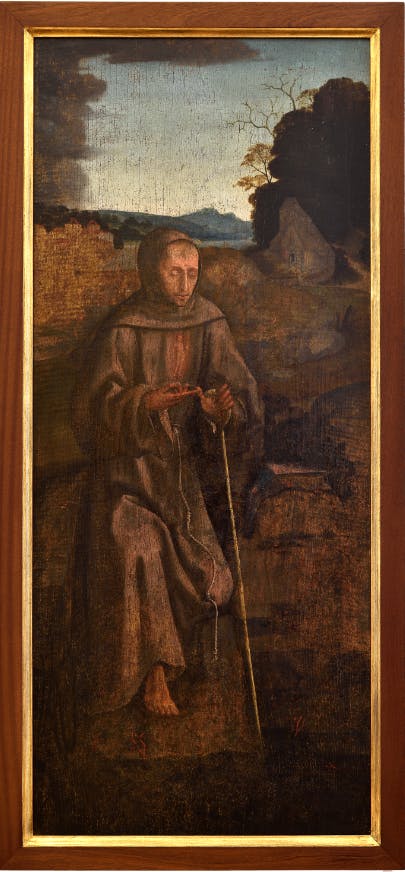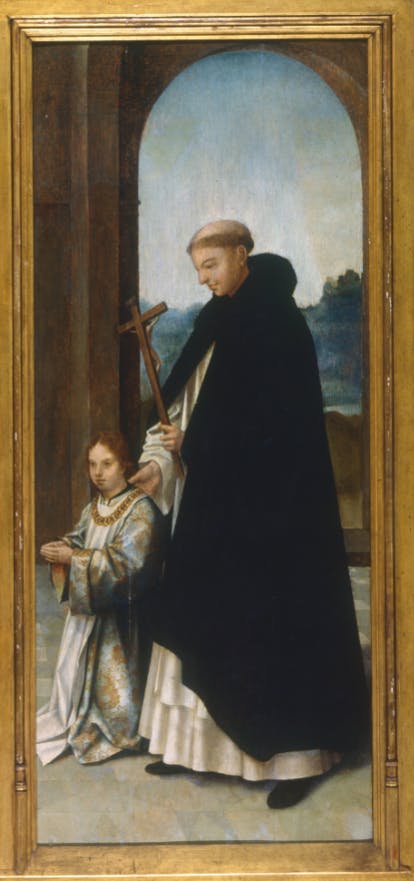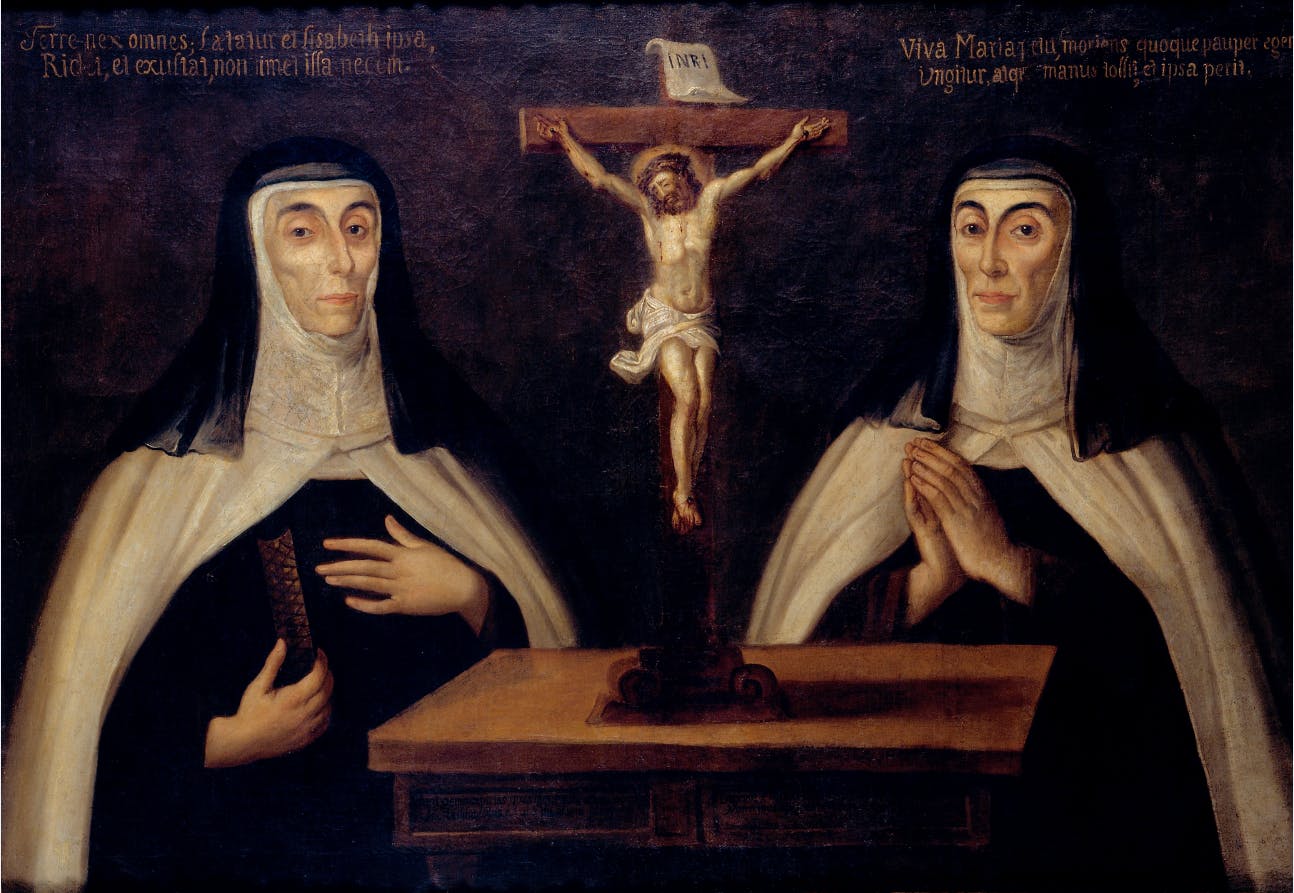Religion in 18th century Portugal was very important. There were many convents and monasteries in the city and surrounding area (around 78): Franciscans, Jesuits, Carmelites, Dominicans, and many other orders could be recognized in the streets of Lisbon by the colour and style of their habits.
Religious habits meant many things for religious orders. They reflected their spirituality and ways of life, but often reflected their financial situations as well. The members of the various Franciscan Orders took vows of poverty, so their grey or brown habits were made of the cheapest and most common fabrics. Other orders, on the other hand, as was the case with some Dominicans, could afford to wear black capes, using the rarest, most expensive dye.
In addition to spiritual devotion and concern for public morality and behaviours, the Catholic Church represented an extensive network of support for the poor and the sick. It was a very vast network of institutions—offering prayer, assistance, liturgical service, health care, and even surveillance over the possession and printing of books, but also imprisonment and judicial power in the form of the Inquisition. The Church regulated the rhythms of public life, organising the ceremonies of the liturgical calendar and the processions, well attended by the people, where groups of artisans and the civil authorities took pride of place. The Church also regulated the times of biological life, accompanying and watching over the people of Lisbon, from birth to death.
Fervent Catholics, many Portuguese persuaded their children to become monks and nuns. Besides spiritual comfort, aristocratic families wanted to secure their influence in society and used the Church to get it. It was also a way for many young men and women to ensure their futures, as only firstborn children would inherit from their parents. For poor families, it was above all a survival strategy. Inside the convents, however, the social hierarchies of the outside were largely maintained, the poor did the heaviest work and the rich had a more leisurely life.
Beyond the day-to-day work, convents were often centres of intense social and cultural interaction, with music, theatre, and readings open to a select audience. This made religious life even more attractive to novices.
But the growing numbers of novices were a source of worry. The excess of friars and nuns had been discussed in Portugal since the 17th century. The king's ministers, interested in the kingdom's economy, despaired about the number of people who were driven away from productive labour in favour of a life of contemplation.
In addition to the very old tradition of agricultural work, some of the religious orders would create goods to sell in order to ensure their financial livelihood. Aristocrats enjoyed visiting monasteries and convents to buy these goods and have the chance to speak to the nuns. During visits to the convents, some aristocrats and nuns would flirt with each other. As unwanted pregnancies would happen, this otherwise well sought-after interaction was under constant scrutiny, from both the king and the religious authorities.
But the religious orders and the ecclesiastical authorities were decisive in the earthquake relief. In the midst of the dust, clerics baptised dying children and offered spiritual help to the victims. There are several testimonies of friars who saved men and women amidst the rubble. Hospitals were improvised in the Sao Bento, Saúde, and Sao Roque Convents. The richest orders mobilised their resources and the Society of Jesus alone housed more than 300 people. The convents opened their doors to receive the wounded and the poor. They also generated some concern, especially the multitude of young and helpless nuns that poured into the streets after the catastrophe. Franciscan, Dominicans, Poor Clares, Trinitarians, Bernards, and Carmelites wandered around the city disoriented and begging for alms. As for the friars whose monasteries had been razed to the ground, they organised processions and assisted the survivors. It was mostly the religious who tended the living and buried the dead.
Of all the products made in monasteries and convents, perhaps the conventual sweets are the most famous. The recipes, often secret, almost always contain sugar and eggs, and evolved from the widespread use of sugar in Portugal in the 15th century. With the extinction of the religious orders, the production of these sweets passed to some specialised confectioneries, which are still open to the public today.
The list of sweets is vast, and their names are almost as delicious as the sweets themselves. Some are linked to the daily life of nuns and have religious references such as queijinho do céu (little cheese from Heaven), fatias de Santa Clara (Saint Clair slices), bolo do paraíso (cake from Paradise), manjar celeste (celestial feast), toucinho do céu (bacon from Heaven), or papos de anjo (angel chests). Others are very funny and provocative, to say the least, such as barriguinhas de freiras (nun bellies), maminhas de noviça (novice tits), beijos de freira (nun kisses), bolas de sacristão (sacristan balls) or gargantas de freira (nun throats). At Quake, we are sure that these saucy names only contribute to their wonderful taste!


Both founded in the Middle Ages, the two main religious orders (Franciscans and Dominicans) differed in their relationship to poverty and study. They were looking for a renewal of spiritual life by distancing themselves from the notion of personal property. They sought to combat deviance and heresy by advocating intellectual deprivation. However, it was impossible to avoid the increasing publication of commentaries on sacred texts, the multiplication of libraries, and metaphysical speculation. As can be seen in the engraving, their vestments reflected this culture of deprivation, illustrated by the coarse cloth bure of the gardeners and poor peasants for the Franciscans or the four simple pieces of black and white cloth Dominicans. Most of the religious orders had developed under the protection of the royal family and the principal aristocrats of the Court, multiplying their different charisms and congregations: Augustinians, Cistercians, Benedictines, Carthusians, Jesuits, Carmelites, Theatines, Paulists, Crusaders, Trinitarians, and Oratorians. By the 18th century, some of these convents, with some of the largest estates in the kingdom, had become critical agricultural estates or centres of learning, with rich libraries, schools, and sumptuous churches. Convents began to dominate the urban landscape, especially in Lisbon. They constituted administrative bodies of great importance, developing accounting, building fences, gardens, vegetable gardens, and orchards that even today mark the countenance of the cities of Portugal.

However, religious orders suffered from many contradictions. On the one hand, they accumulated books, manuscripts, paintings, and works of art; practised poetry wrote erudite commentary, and promoted women's abilities—whether in managing monasteries, convents, and abbeys, or in how they expressed certain forms of conviviality, with music, poetry recitations, and liturgical chants. On the other hand, they were growingly removed from the kingdom's political and social life, with accusations of idleness and sexual repression. Many nuns did not fail to impress travellers. At the end of the 18th century, there were no less than 125 religious houses, with the Dominican (17) and Franciscan (57) orders having the most significant number of convents. But there were also the Augustinians (Calced and Discalced), Benedictines, Bernardines, Poor Clares, Brigittines, Carmelites (Calced and Discalced), Hieronymites, Ursulines, Sisters of the Annunciation, Salesians, and Third Orders. Not all of these nuns lived cloistered, but many mortified their bodies and minds by observing a mystical asceticism, leaving behind legends of sanctity. Apart from those who took part in a fashion, subversive to say the least, which consisted in welcoming aristocrats, jurists, poets, and army officers for gallant encounters, many others, on the other hand, collaborated actively in the life of the cities by teaching, writing devotional manuals, literary criticism, and a particular influence on the politics of the Court.
Places to visit
- Museu de LisboaExplore
- Museu Nacional de Arte Antiga, LisboaExplore
- Convento da Madre de Deus, Museu do Azulejo, LisboaExplore
- Museu do Traje, Lumiar, LisboaExplore
- Convento dos Cardais, LisboaExplore
- Mosteiro de São Vicente de Fora, LisboaExplore
- Convento de Mafra, MafraExplore
- Museu de Aveiro, AveiroExplore
Continue Exploring
Bibliography
Francisco da ANNUNCIAÇÃO, Vindicias da virtude e escarmento de virtuosos nos públicos castigos dos hipócritas dados pelo Tribunal do santo Oficio, 3 vols., Na officina Ferreiriana, 1725-1726.
Charles BOXER, A Igreja e a expansão Ibérica (1440-1770), Edições 70,1989.
Manuel Bernardes BRANCO, História das Ordens Monásticas em Portugal, 3 vols, Livraria Editora de Tavares Cardoso & Irmão, 1888.
José Sebastião da SILVA DIAS, Correntes do sentimento religioso em Portugal, séculos XVI a XVIII, 2 vols, Universidade de Coimbra, 1960.
Maria Amélia Dias FERREIRA, O Socorro às Vítimas do Terramoto em Lisboa (1755), Tese apresentada à Universidade Católica Portuguesa para obtenção do grau de doutor em Enfermagem na especialidade de História e Filosofia de Enfermagem, 2016.
António Camões GOUVEIA, «Estratégias de interiorização da disciplina», História de Portugal, O Antigo Regime (1620-1807), (vol. 4), António Manuel HESPANHA, (coord.), Editorial Estampa, 1992, pp. 415-449
Carl A. HANSON, Economia e Sociedade no Portugal Barroco (1668-1703), D. Quixote, 1986.
Ana HATHERLY, «Tomar a palavra: aspectos de vida da mulher na sociedade barroca», Revista da Faculdade de Ciências Sociais e Humanas, n. 9, Edições Colibri, 1996, pp.269-280.
Maria Antónia LOPES, Protecção Social em Portugal na Idade Moderna, Imprensa da Universidade de Coimbra, 2010.
João Francisco MARQUES, “A acção da igreja no terramoto de lisboa de 1755: ministério espiritual e pregação”, Lusitania sacra, 2ª série, 18., 2006.
Ediana Ferreira MENDES, Da Universidade de Coimbra ao Brasil: os bispos da Baía, de Olinda e do Rio de Janeiro (1676-ca.1773), Tese de Doutorado em História, Faculdade de Letras da Universidade de Coimbra, 2018.
José Pedro PAIVA, Baluartes da fé e da disciplina: o enlace entre a Inquisição e os bispos em Portugal (1536-1750), Imprensa da Universidade de Coimbra, 2011
Beatriz Catão Cruz SANTOS, O Corpo de Deus na América. A festa de Corpus Christi nas cidades da América Portuguesa, século XVIII, AnnaBlume, 2005.
Antônio P. da SILVA, A questão do sigilismo em Portugal no século XVIII: história, religião e política nos reinados de D. João V e D. José I, Tip. Ed. Franciscana, 1964.
Laura de Mello e SOUZA, O diabo na Terra de Santa Cruz, Feitiçaria e religiosidade popular no Brasil colonial, Companhia das Letras, 1989.